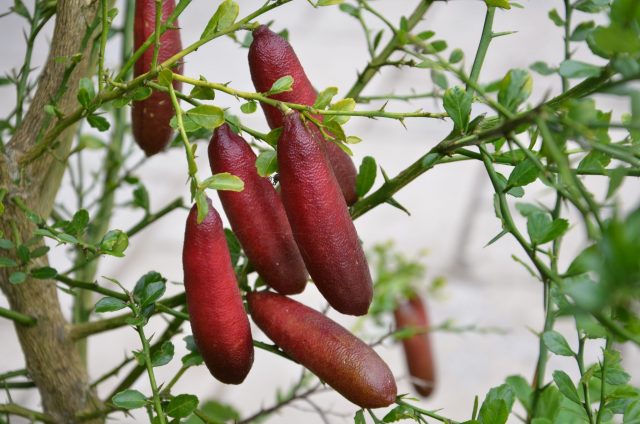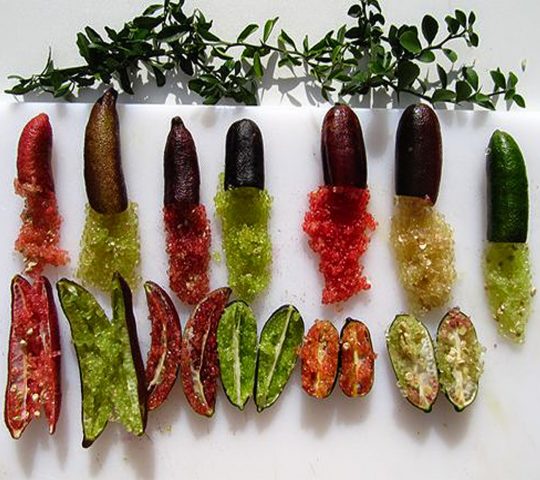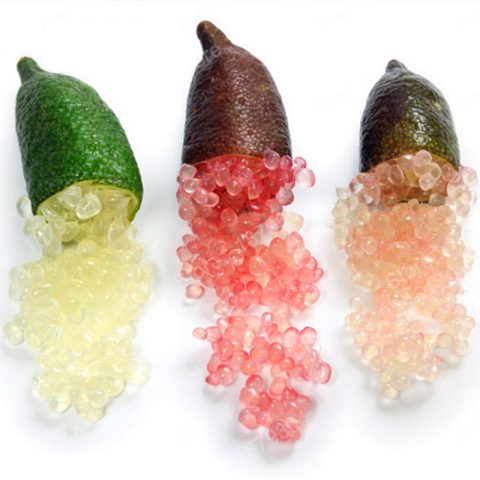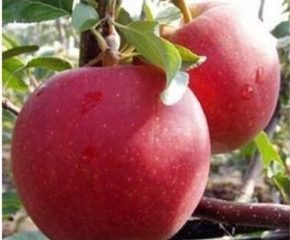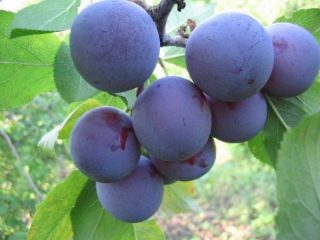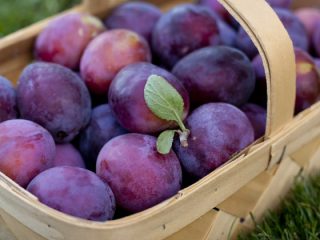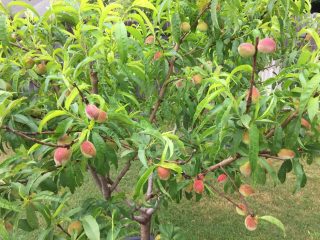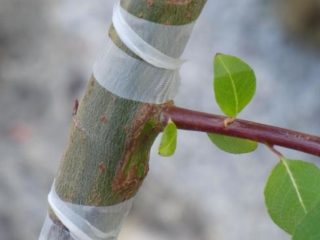Content
Finger lime - a tree-like plant in the form of a shrub or tree (figner lime) is a rare exotic representative of the Citrus genus. Differs from the usual citrus crops in color, shape and internal content of the fruit. The wild species has given rise to many hybrid varieties that are grown commercially on plantations.
Where does finger lime grow
The historical homeland of the finger lime is Australia, more precisely, the tropical forests of the Eastern part of the country. The plant got into botanical reference books in 1859, it was discovered in the states of South Wales and Queensland. In its natural environment, fingerlime forms undergrowth near tall trees. Optimal conditions for vegetation are shade from the crown, high air humidity, loamy soils, and sufficient rainfall.
At the end of the 20th century, the culture began to be grown in large quantities. The demand for finger lime fruits was several times higher than the proposed export volumes. Finger limes are grown in coastal areas in Eastern Australia. The country is the main supplier of fruits and seedlings. Finger lime is very popular in America. In the United States, the plant is cultivated on large plantations in the state of California, here the climate is as close as possible to its natural habitat. Finger lime is found in Thailand and Italy.
Description of finger lime
Finger lime is a rare plant with a limited growing area. Depending on the weather conditions and the place of growth, it is shaped like a shrub or tree. Shrub varieties reach a height of up to 3 m, a tree - up to 8 m. The culture blooms in late autumn, after 6 months the fruits begin to ripen. On the basis of the wild-growing species, remontant varieties have been created, in which the first harvest is carried out in June, the last fruits are removed in November.
External characteristics of the Australian fignerine:
- The trunk of the tree and the central branches of the shrub are of the same volume within 3-4 cm, upright. The culture is slightly branched, the color of young shoots is light green, the trunk is gray-brown, the bark is dense, rough. The plant has long green spines. The crown is thin, the foliage is average.
- Unlike other citrus fruits, finger lime forms small, opposite leaves. The leaf plate is dense, bright green, lanceolate with a glossy surface.
- During budding, the finger lime is completely covered with rounded small balls, the flowers are simple single, pink or white with a yellow core and orange stamens.
The exotic fruits of the finger lime are filled with numerous rounded vacuoles, the diameter of which is 4-5 mm, they resemble fish eggs.
The internal content of the fruit is a sour juice. The shape of an oblong oval in the form of a finger, tapering towards the apex. Weight - 150 g, length - 8-10 cm. The peel is thin, the surface is small-knobby. When the lime of the finger peel ripens, bubbles filled with juice appear on the surface.
The color of the fruit depends on the variety of finger lime:
- Red australian - fruit and pulp of a rich burgundy color;
- Faustin - the surface and oval vacuoles are yellow;
- Australian Sunrise - pear-shaped orange fruits, bright yellow rounded juice-containing sacs;
- Rainforest pearl - a hybrid with pink flesh and green-burgundy skin;
- Durham emerald - black fruit with blue-green pulp;
- Blunobia pink crystal - the surface is brownish brown, the inner part is dark pink;
- Alstonville - dark green surface, bright pink flesh.
The perennial crop grows slowly, begins to bear fruit at the age of 7 years, hybrid varieties of finger limes grafted onto the stock give fruit 3 years earlier.
Benefit and harm
The chemical composition of finger lime includes a set of vitamins and trace elements that are involved in almost all body functions:
- Vitamin composition: group B, Ascorbic acid, Phylloquinone, Alpha-tocopherol, Nicotinamide, Retinol. These components dissolve fats, increase the energy level, participate in the regeneration of the skin, stabilize protein metabolism, acid-base balance, contribute to the normalization of hemoglobin, enhance the defense response to viral and bacterial infections, act as antioxidants, and control the level of sugar and cholesterol in the blood.
- Potassium protects cell membranes from negative effects, maintains water balance. Inhibits cardiological pathologies.
- Calcium is a building material for bones and teeth. It carries the function of an absorbent, relieves the body of toxic substances, improves blood clotting.
- Magnesium strengthens the heart muscle, normalizes blood circulation.
- Sodium is involved in the absorption of calcium, takes an active part in the function of the digestive tract, strengthens the nervous system.
- Iron promotes the production of hemoglobin, enhances the process of hematopoiesis.
- Selenium prevents the development of eye diseases, improves vision.
Eating finger lime contributes to:
- strengthening immunity;
- relief of inflammatory processes;
- improving digestion;
- prevention of cardiovascular diseases;
- stimulation of the kidneys and the endocrine system;
- blocking the development of anemia;
- the strength of the skeletal system;
- improving the condition of the skin, hair, teeth, nails.
The exotic Australian fruit is used in the cosmetic industry. The chemical composition includes essential compounds, on the basis of which oil for shampoos and hair conditioners is produced. Finger lime improves the condition of the hair, eliminates dandruff, and normalizes the secretion of the sebaceous glands. The juice is included in lotions and creams designed to cleanse the skin, give it a healthy look, and prevent age-related changes.
The benefits of finger lime are undeniable, but there are a number of contraindications, in which it is undesirable to include citrus in the diet. Contraindications:
- individual intolerance;
- lactation period;
- children under 3 years old;
- exacerbation of gastrointestinal tract pathologies: ulcer, colitis, gastritis;
- cholecystitis.
People with dysbiosis must be approached with caution. Diarrhea may occur.
How to eat finger lime
The popularization of finger citrus is gaining momentum every year. In some restaurants, pulp has become a branded ingredient in dishes. Citrus is an essential ingredient in Latin American recipes and is widely used in Southeast Asian cuisine. In Russia, finger lime is not so popular due to the high price offer and insufficient supply to the retail network. Finger Lime Applications:
- juice is part of the sauce for chicken and fish;
- season sushi;
- goes as a decoration for desserts;
- included in sandwiches;
- cocktails are decorated with citrus "caviar";
- added to alcoholic beverages.
At home, you can make jam, marmalade. The dried and ground zest is used as a spice seasoning. Due to its ability to break down fats, finger lime is included in diets to normalize weight, cleanse the body.
Calorie content
The fruits of the Australian finger lime are low-calorie foods. Daily use in moderation is indicated for people who are overweight. If you include finger lime in your diet for weight loss, the results will be noticeable after 2 months. The calorie content of a citrus fruit is 30 kcal per 100 g of weight, of which:
- carbohydrates - 7.7 g;
- proteins - 0.65 g;
- fats - 0.19 g.
Fruits with a low calorie content and with a high energy composition with a minimum amount of sugars are recommended for everyone, except for people with contraindications.
How to grow finger lime at home
The wild Australian finger lime can be grown in the Russian climate only in the subtropical zone of the Krasnodar Territory. Hybrid varieties are more resistant to temperature drop, they can withstand up to -3 0C. Grow the culture in a temperate climate in a semi-permanent way. A tree plant is planted in a tub, brought into the room for the winter, and exposed to an open area in the summer.
Agricultural requirement:
- The place for the finger lime is chosen shaded - under the protection of tall trees.
- The air humidity should be high.
- The soil is fertile, but you can grow a seedling on loamy soil.
- Finger limes are propagated by layering or grafting on the stock of a more frost-resistant citrus culture.
- Watering is carried out in accordance with the precipitation, at least 1 time in 2 days, in winter it is irrigated by drip.
- Mandatory pruning is required. Immediately after fruiting, old branches are removed; the crown must not be allowed to thicken.
- The plant is fed in the spring during flowering; complex mineral fertilizers for citrus crops are suitable.
Conclusion
Finger lime is a perennial tree plant belonging to rare exotic crops. Originally a Citrus from the Australian rainforest, it prefers a warm and humid climate, a partially shaded area and a complete absence of drafts and low temperatures. The fruits are used in cooking as a seasoning for fish and chicken dishes. Used to decorate desserts and cocktails. By creating conditions as close as possible to their natural habitat, you can grow a finger lime at home.
